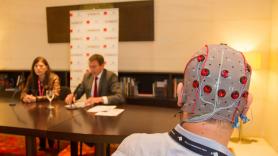2. Brain/computer interfaces: towards a brain-machine relationship
The electric signals produced by the brain can also be interpreted to a certain extent. By decoding these signals, patients who are paralyzed, for example, can move robotic hands and arms with their thoughts, or even guide their own wheelchairs.
When Jean-Dominique Bauby woke up after a massive stroke, he could only move his left eyelid. The former editor-in-chief of Elle magazine managed to write, with the help of an assistant, his book “The Diving-Bell and the Butterfly” by blinking when the assistant said the next letter to be written. But to do so, she had to say the alphabet over and over again.
Now, brain/machine interfaces allow patients to write directly with their thoughts. The speed record is currently at 0.8 seconds per word and there are already applications like Intendix that allow patients who are totally paralyzed to write and send e-mail.
José del R. Millán, professor at the Ecole Polytechnique Fedérale de Lausanne, is working to perfect interfaces to control wheelchairs, which isn’t an easy task. “There are unavoidable errors,” he says, “but these can be minimized by incorporating automatic learning techniques into computers to help them learn from the mistakes.” To do this, they introduce mechanisms that give feedback on how the movement is going. And it could even help in therapy, for example, for patients who have had a stroke, as the brain could improve its plasticity by receiving the feedback and adapting to the new mechanism. “The goal is to combine function replacement and rehabilitation into one device,” explains Millán. This is why he calls for increased funding for clinical trials, which are “the only way to make sure these advances become a reality.”
We can’t discard the possibility that, in the future, paralytic patients may walk again with an exoskeleton. This is the goal, for example, of the Walk Again Project, launched at the inauguration of the Football World Cup in Brazil in 2014. For Mikhail Lebedev, researcher at Duke University, “This is something we will surely see very soon.”
New techniques, new knowledge, new possibilities
Technological breakthroughs lead to new knowledge and applications. For example, voltage-sensitive colorants allow us to see how the neurons in the brain are activated in real time. This allows us to identify what are called “slow brain waves”, which are activated and spread through the brain periodically and while we are asleep and help consolidate memory. “They are essential,” says Sánchez-Vives, “because the brain can’t be inactive. They are the compromise solution, allowing it to rest without suffering any negative consequences.”
Other new techniques include optogenetics and optopharmaceuticals, which control neuron activity using specific types of light. The first uses algae genes introduced into neuron cells through viruses. This could lead to safety problems in humans. Pau Gorostiza, ICREA research professor at the Institute for Bioengineering of Catalonia (IBEC), is working to develop drugs that attach to neurons and make them light sensitive. “If effective, they could be regulated like any other sort of drug,” he says.
Researchers are also developing new materials to improve electric devices implanted in the brain. One of the most promising materials is graphene, which has highly unique properties, as explains Gemma Gabriel-Buguña, researcher at the Barcelona Microelectronics Institute, “It is flexible, transparent and biocompatible. And even harder than diamonds.”



